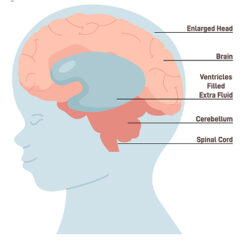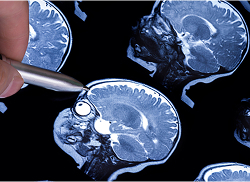What Is Hydrocephalus in Infants?
 Hydrocephalus is a serious medical condition occurring when cerebrospinal fluid (CSF) builds up in a baby’s brain. It can be present at birth (congenital) or develop soon after due to complications or preventable birth injuries.
Hydrocephalus is a serious medical condition occurring when cerebrospinal fluid (CSF) builds up in a baby’s brain. It can be present at birth (congenital) or develop soon after due to complications or preventable birth injuries.
“Although it translates as ‘water on the brain,’ the word actually refers to the buildup of cerebrospinal fluid, a clear organic liquid that surrounds the brain and spinal cord.”
—American Association of Neurological Surgeons
Cerebrospinal fluid cushions the brain and spinal cord while providing nutrients and removing waste. CSF is then absorbed into the bloodstream and replaced by new fluid, but when it cannot flow or drain properly, it creates pressure inside the skull.
In infants, hydrocephalus often causes an unusually large head or rapid head growth. If untreated, the pressure can damage brain tissue and lead to long-term complications, including developmental delays, seizures, and vision problems.
When hydrocephalus is caused by a preventable birth injury, families may be able to take legal action. A hydrocephalus lawyer can help determine what went wrong during delivery and whether medical negligence played a role.
The Birth Injury Justice Center has partnered with lawyers who can help families in all 50 states. Our legal partners have secured over $1 billion for families affected by birth injuries.
Find out if we can help your family — get a free case review now.
Hydrocephalus Symptoms in Babies
Symptoms of hydrocephalus can vary widely and depend on a child’s age and how advanced the condition is.
- Bulging eyes and difficulty looking up when facing forward
- Extreme tiredness
- High-pitched cry
- Irritability or fussiness
- Large head
- Poor feeding
- Rapid increase in head size
- Seizures with no known cause
- Severe and frequent vomiting
- Soft spots on the head that may bulge
- Visible scalp veins
If your baby has been diagnosed with hydrocephalus, you may still be left with questions — especially if the signs appeared after a difficult or traumatic delivery.
Our labor and delivery nurses can review what happened and help you understand whether a preventable birth injury may have occurred.
There’s no cost to speak with one of our nurses, and no pressure to take legal action. Connect with a nurse right now.
What Causes Hydrocephalus in Babies?
Hydrocephalus in infants is often congenital. However, it can also develop shortly after due to complications that affect the flow of cerebrospinal fluid through the brain.
- Aqueductal stenosis (narrowing of a passage in the brain)
- Birth injuries involving head trauma or swelling
- Bleeding in the brain, such as intraventricular hemorrhage
- Brain malformations, tumors, or cysts
- Maternal infections
- Meningitis or other brain infections
- Premature birth
- Spina bifida (opening to the spine) or spinal cord defects
In some cases, hydrocephalus develops after a difficult delivery. Improper use of tools like forceps or vacuum extractors may cause head trauma that disrupts normal CSF flow. When that happens, medical negligence may be to blame.
Medical Negligence and Hydrocephalus in Infants
Although hydrocephalus can be genetic or caused by a range of medical issues, some cases are the result of medical negligence, causing bleeding or trauma to the brain.
- Delaying a C-section after signs of fetal distress
- Failing to diagnose or treat a maternal infection
- Ignoring any red flags of the baby’s condition during labor
- Mismanaging shoulder dystocia (baby is lodged behind pelvis)
- Missing signs of a brain bleed after a baby is born
- Misusing forceps or vacuum extractors
- Neglecting to monitor or treat premature labor
- Overlooking oxygen deprivation during delivery
If a hydrocephalus baby was harmed by poor medical care, families may have legal options. Compensation from a hydrocephalus lawsuit may help ease the financial burden of multiple surgeries, specialist visits, mobility aids, and long-term care.
Most parents are never told that hydrocephalus could be tied to a mistake during childbirth. If something felt wrong during labor, or if your baby showed signs of distress before developing symptoms, you may be eligible for compensation.
Get a free case review right now to find out if we can connect you with a top attorney near you.
Complications of Hydrocephalus in Children
It is difficult to predict hydrocephalus complications in infants. Since the condition injures the brain, children may experience a range of issues as they grow. Additionally, complications from surgery and shunts used to treat hydrocephalus in infants may arise.
- Balance and coordination problems
- Blurred or double vision
- Developmental delays
- Difficulty standing or walking
- Early onset of puberty
- Epilepsy (seizure disorder)
- Learning disabilities
- Loss of bladder control
- Memory and focus challenges
- Nausea and vomiting
- Severe headaches
- Short-term memory loss
- Sudden personality change
- Vision problems
In milder cases or when treatment is highly successful, hydrocephalus in infants may lead to completely normal development.
Hydrocephalus symptoms often mimic symptoms of other conditions. Therefore, it is important to work with your child’s health care provider to get an accurate diagnosis.
If your child’s condition could have been prevented with proper care, you may be able to file a hydrocephalus claim and pursue compensation to support your child’s long-term needs.
Types of Hydrocephalus in Infants
There are two main types of hydrocephalus, both involving a buildup of cerebrospinal fluid in the brain but caused by different underlying issues. Learn about the types of hydrocephalus below.
Communicating Hydrocephalus
This type occurs when CSF is able to flow through the brain’s ventricles (cavities) normally, but is not properly reabsorbed into the bloodstream.
The problem lies in how the body manages the fluid rather than with a physical blockage.
This form may result from conditions like meningitis, bleeding, or other complications that affect the brain’s ability to absorb CSF.
Obstructive Hydrocephalus (Non-Communicating)
This type occurs when something physically blocks the flow of CSF within the brain. It’s often caused by a structural problem, such as aqueductal stenosis (narrowing that blocks a canal in the brain), a cyst, or a brain tumor. The blockage causes fluid to back up, increasing pressure inside the skull.
Both types of hydrocephalus can be present at birth or develop after delivery due to trauma, bleeding, or infection. In either case, early diagnosis and treatment are critical to help prevent permanent damage.
When the condition is caused by medical negligence, many families seek hydrocephalus settlements to help afford the best possible care for their child.
How Is Hydrocephalus Diagnosed in Babies?


Additionally, hydrocephalus in infants and older children is usually diagnosed in one of three ways: ultrasound, computed tomography (CT scan), and magnetic resonance imaging (MRI).
Ultrasound
Ultrasounds use sound waves to create images of the inside of the body. During pregnancy, an ultrasound can show ventricle size in a baby’s brain. Ultrasounds can also be performed after a baby is born.
CT Scans
A computed tomography scan uses X-rays to create visuals of the baby’s brain, helping doctors see fluid buildup, bleeding, or other signs of injury.
MRI
Magnetic resonance imaging combines large magnets and radio waves to show detailed images of organs inside a baby’s body.
Early diagnosis is important for babies with hydrocephalus. Identifying the condition quickly allows doctors to start treatment before pressure causes more damage.
With the right tests and prompt care, many babies can avoid serious complications and get the support they need for healthy development.
Treatment of Hydrocephalus in Infants
There is currently no treatment for hydrocephalus during pregnancy. Instead, a baby will be monitored carefully for signs of distress while still in the womb. If problems are detected, early delivery may be required.
Once a baby is delivered, treatment will depend on symptoms, general health, and the severity of the condition. However, hydrocephalus in infants is typically treated with surgery.
- Ventriculoperitoneal (VP) shunt surgery: The most common treatment is a shunt, a thin and flexible tube placed in the brain or spinal cord to drain CSF.
- Endoscopic third ventriculostomy (ETV): This may be an option for older children. It is minimally invasive and creates an opening for trapped CSF to escape into its natural pathways.
- Combined endoscopic third ventriculostomy/choroid plexus cauterization (ETV/CPC): This procedure can be used in most cases to reduce the rate of CSF production and provide new routes for CSF to escape.
Hydrocephalus in infants usually gets worse over time and increases the levels of pressure in the brain. If this pressure isn’t relieved, it can lead to permanent brain damage.
The key to treatment is early diagnosis. A shunt is usually required, which means your child will need regular checkups to monitor how it is working. The shunt will also need to be adjusted as your child grows.
While treatment for hydrocephalus in infants is usually successful, most children need multiple surgeries and ongoing medical care.
Get Legal Help for Hydrocephalus in Infants
If your child’s hydrocephalus could have been prevented, you may be able to take legal action. Poor decisions during delivery — like using forceps incorrectly or waiting too long for a C-section — can cause brain damage that leads to fluid buildup and lifelong complications.
Caring for a child with hydrocephalus often means ongoing surgeries, shunt monitoring, therapy, and support that most families never planned for. When medical negligence is to blame, no one should have to cover these costs alone.
We work with experienced birth injury lawyers who can help families in all 50 states.
Our legal partners have secured more than $1 billion for families affected by preventable birth injuries, and they may be able to help your family, too.
Call us at (800) 914-1562 right now or fill out our case review form to see if we may be able to help you seek the justice and compensation your family deserves.
Hydrocephalus in Babies FAQs
What is hydrocephalus?
Hydrocephalus is a condition where excess cerebrospinal fluid builds up in the brain. This fluid puts pressure on the brain and can cause the head to grow larger. It may affect brain development and function if not treated.
How common is hydrocephalus in babies?
Hydrocephalus is one of the most common brain disorders in children. About 1 in every 500 babies is born with hydrocephalus, and thousands more develop it before age 2, according to Stanford Children’s Health.
What is the life expectancy of a person with hydrocephalus?
With early diagnosis and proper treatment, many people with hydrocephalus can live long, full lives. Life expectancy depends on several factors, including the underlying cause, when treatment began, and whether any complications developed.
If your child’s hydrocephalus was caused by medical negligence, you may be able to file a birth injury lawsuit. This can mean accessing financial compensation to help cover the cost of care and give your child the best possible chance at a healthy future.
Get a free case review right now to find out if our team can help you get started.
What is the main cause of hydrocephalus?
Hydrocephalus is caused by a variety of factors, including brain bleeds, infections, tumors, or problems during pregnancy or delivery. In some babies, it develops before birth, while others may develop it after a brain injury or infection.
While hydrocephalus is sometimes unavoidable, it can also be caused by medical mistakes made by delivery teams. If you have questions about what caused your child’s condition, we may be able to help.
Call us at (800) 914-1562 right now or Click to Live Chat to see if we can connect you with a top attorney near you.
Can you live a full life with hydrocephalus?
Yes, many children and adults with hydrocephalus live full and active lives, especially when they receive early and ongoing medical care. Treatment often involves placing a shunt to drain the extra fluid and relieve pressure on the brain.
Can hydrocephalus be cured?
There is no cure for hydrocephalus, but it can often be managed successfully with surgery and ongoing care. Most people with hydrocephalus need a shunt or other procedures to control the fluid and prevent damage to the brain.




